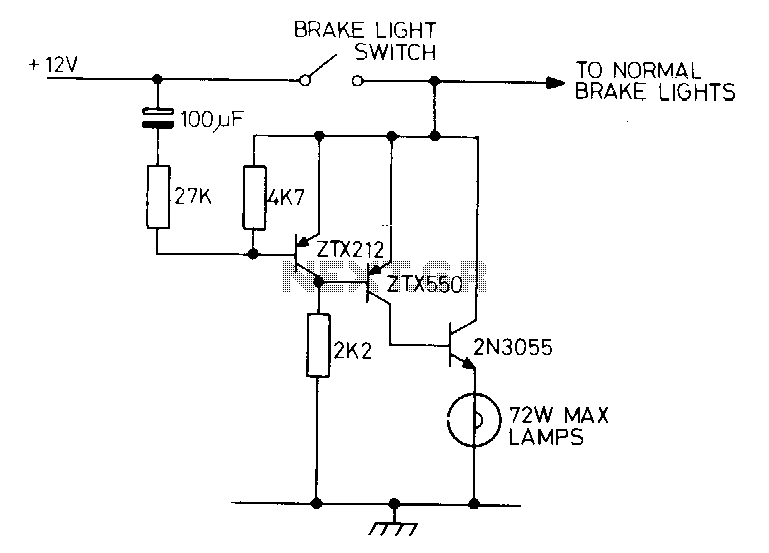
Delayed-extra-brake-light

Activating the brake pedal in a vehicle triggers the standard brake lights, followed by a delay before the additional lights are illuminated. A bimetal strip connected in series with the lights can create a flashing effect.
The described circuit operates on the principle of sequential illumination of brake lights in response to the brake pedal being pressed. Initially, when the brake pedal is engaged, the regular brake lights are activated, signaling the vehicle's deceleration to following drivers. After a predetermined delay, additional brake lights are illuminated to enhance visibility and alert other road users of the vehicle's stopping action.
The inclusion of a bimetal strip in series with the brake lights introduces a flashing mechanism. This component consists of two different metals bonded together, which expand at different rates when heated. When the brake lights are activated, current flows through the bimetal strip, generating heat. As the temperature rises, the bimetal strip bends due to the differential expansion of the metals. This bending action can be designed to interrupt the current flow, causing the lights to turn off momentarily before the strip cools and the current resumes, resulting in a flashing effect.
The circuit typically includes a delay mechanism, such as a capacitor-resistor (RC) timing circuit, to ensure that the additional lights do not activate instantaneously but rather after a brief interval. This delay can be adjusted to suit specific requirements, providing flexibility in the design. The overall configuration improves the safety of the vehicle by making the brake signal more prominent and noticeable to other drivers, particularly in low visibility conditions.
In summary, the described electronic schematic enhances vehicular safety through a combination of sequential lighting and a flashing mechanism, utilizing a bimetal strip to create an effective warning signal for following traffic.Operating the brake pedal of the car brings on the normal brake lights and then, after a delay, the extra lights are turned on. A bimetal strip in series with the lights would make them flash.
The described circuit operates on the principle of sequential illumination of brake lights in response to the brake pedal being pressed. Initially, when the brake pedal is engaged, the regular brake lights are activated, signaling the vehicle's deceleration to following drivers. After a predetermined delay, additional brake lights are illuminated to enhance visibility and alert other road users of the vehicle's stopping action.
The inclusion of a bimetal strip in series with the brake lights introduces a flashing mechanism. This component consists of two different metals bonded together, which expand at different rates when heated. When the brake lights are activated, current flows through the bimetal strip, generating heat. As the temperature rises, the bimetal strip bends due to the differential expansion of the metals. This bending action can be designed to interrupt the current flow, causing the lights to turn off momentarily before the strip cools and the current resumes, resulting in a flashing effect.
The circuit typically includes a delay mechanism, such as a capacitor-resistor (RC) timing circuit, to ensure that the additional lights do not activate instantaneously but rather after a brief interval. This delay can be adjusted to suit specific requirements, providing flexibility in the design. The overall configuration improves the safety of the vehicle by making the brake signal more prominent and noticeable to other drivers, particularly in low visibility conditions.
In summary, the described electronic schematic enhances vehicular safety through a combination of sequential lighting and a flashing mechanism, utilizing a bimetal strip to create an effective warning signal for following traffic.Operating the brake pedal of the car brings on the normal brake lights and then, after a delay, the extra lights are turned on. A bimetal strip in series with the lights would make them flash.